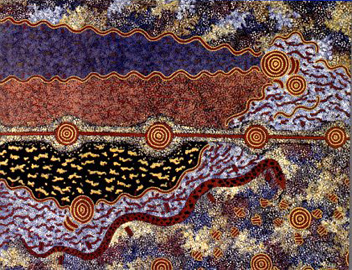Indigenous History
The name Aborigine is given to those people who are the first inhabitants of a place or country. Australia’s Aboriginal people do not call themselves Aborigines, but rather prefer to be called Indigenous Australians. There are many different groups of Indigenous Australians and they all have different names depending on which language they speak and where they live. The name Aborigine was given to native Australians by European settlers during the 1700s. Indigenous Australians are divided into two groups, those living in the mainland and those living on the Torres Strait Islands.
Indigenous Australians believe that their ancestors were created at the beginning of the world and have always lived in Australia. Once, long ago, Indigenous Australians lived throughout Australia on over 250 different groups all sharing a common religion, but speaking different languages and having different customs. Each group occupied a particular homeland and respected the homelands of other groups.
Men were traditionally hunters, collecting food by hunting emus, kangaroos, turtles and seals. Women caught smaller animals such as snakes and possums. They also collected seeds, eggs and dug roots for food. Indigenous Australians also made all of their tools such as knives, shields, bowls and water bags.
During 1829 and 1901, European settlers set up government across the land and made laws which they expected Indigenous Australians to abide by. During the 1900s the Australian government tried to engage Indigenous Australians in as much European culture as possible. From 1910 to 1970 officials took thousands of mixed race children from their families and placed them with white families. Mixed race children are those that are born from Indigenous Australian and European marriages. This group of children taken from their families was given the name “the stolen generation” from the Indigenous Australian people. Many of these children never saw their Indigenous families again and were often beaten and abused by their white families.
From the beginning of the European settlement, Indigenous Australians were forced to live in reserves run by churches and the government, pressured to follow a religion different from their own. On these reserves families were often split up, people weren’t allowed to speak their native languages or practice their traditions. Indigenous Australians more often then not were not allowed an education or the ability to run their own business. Rather many were forced to work for white people as farmhands and other workers. In 1967, a political activist group led a public vote to have the harsh laws against Indigenous Australians changed. For the first time Indigenous Australians were officially a part of Australian society.
These days, the Australian government is working towards integration between Indigenous Australians and non-Indigenous Australians. In the 1990s all major church groups apologised to Indigenous Australians for adding to their hardship. Although the government has started giving lands back to it’s original owners, there is still a long way to go. Indigenous Australians not only want to preserve their scared sites and protect natural environments, but also teach non-Indigenous Australians about traditional ways.
In strict Indigenous Australian culture, there was a strong sense of kinship. Each member of the family helped each other by caring for children, the elderly and the sick, these rules governed how people behaved towards each other. Traditionally, Indigenous Australians had arranged marriages by their parents, some children being promised to another before they were even born. Communication over long distances was done using smoke signals. Different timbers created different coloured smoke which allowed people to relay messages about news, enemies and even asking for help in carrying animals home from a hunt.
Believing that their ancestors live on as spirits, Indigenous Australians connect with them through storytelling, dancing, singing and playing music. Art was not seen as a talent that only a few possessed but rather a part of their religious beliefs and everyday life. Indigenous Australian music was originally used to help people with birth, healing, comfort, grieving and also to help the spirits of the dead depart. In modern times, Indigenous Australian song and dance is used to tell stories, record history and teach. Although the main instrument used is the voice, other instruments such as clap sticks, didjeridus, clapping and drums are also used.
A person’s Dreaming refers not to something that happens when they sleep but rather to a person’s spiritual connection to the beginning of all things. For many Indigenous Australians the Dreaming spirits are still active and relationships are renewed through song, dance and storytelling. Dreaming stories are still told today by many Indigenous Australians.
Information for this page was gathered from:
Bartlett, A. (2004). The Aboriginal peoples: First peoples of Australia. Malaysia: Marshall Cavendish International.
